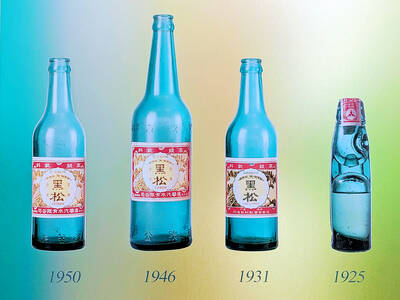Spanish home cooking is now just an MRT and bus ride away. El Patio de Mi Casa, located in an alley near Nanjing East (南京東) and Songjiang (松江) roads, is run by Luis Miguel Hernando and Ramses del Cura Nogal, two thirtysomething Spanish expats.
Before moving to their current locale last December, the pair had operated out of a residential apartment on Jilin Road (吉林路) for two years, serving dinners by reservation for around a dozen people five nights a week.
Word spread quickly about Hernando’s culinary skills and his family recipes, as well as the after-meal entertainment — both Hernando and Nogal are musicians. The two often found themselves turning down customers, and after getting sick of dealing with neighbors complaining about the noise, they finally decided to open a proper restaurant.
Step into their cozy cafe, which seats around 25 people, and the first thing that hits you is a savory aroma from the kitchen.
My dining companions thought it was freshly baked bread, which the restaurant doesn’t serve, but the smell could have been the costillas a la miel (香料白酒蜂蜜肋排, NT$350) — spare ribs with a honey glaze topped with stewed onions and tomatoes.
Hernando says the ribs are marinated ahead of time and slow-roasted for several hours. Aside from the borderline-overwhelming sweetness, this dish was heavenly for its succulent meat, which slid right off the bone.
One basic characteristic of Spanish food is that it’s “cooked slow,” says Hernando. But this probably doesn’t apply to another must-try dish, sepia de la plancha (香煎花枝, NT$200), or pan-seared calamari slices, which were perfectly tender and not in the least bit chewy. And as if its buttery texture weren’t enough, the calamari gets coated with garlic mayonnaise, which is made fresh every day.
For something simple and wholly satisfying, go for the revuelto jardinero (花園炒蛋, NT$220), Spanish-style fried eggs with mushrooms and asparagus. Despite the familiar ingredients, this concoction is a pleasing discovery. The eggs are constantly mixed while in the pan, according to Hernando, which produces a soft and creamy texture.
Hernando describes the tortilla espanola (NT$120 for one serving or NT$600 for a whole pie) as a staple food made of staple ingredients: eggs, potatoes and olive oil. We didn’t order this, but the cake-shaped dish appeared to be a popular choice, judging by a glance at neighboring tables.
The menu, which is in Spanish and Chinese, also lists tapas-style dishes such as datil con jamon iberico (伊比利火腿椰棗, Iberian cured ham with dates, NT$100). We enjoyed both the setas y champis a la plancha (乾煎蘑菇香菇, pan-fried shitake and white button mushrooms cooked with white wine, NT$180) and tomato asado (鐵烤番茄, roasted tomatoes stuffed with pork, NT$100).
The restaurant also honors off-menu requests made in advance, including gazpacho and cocido madrileno, a traditional Spanish stew.
Smaller parties are at a disadvantage, only because they can sample fewer dishes. And they might miss out on trying the seafood paella (NT$1,000 per serving), which is only served for at least four persons. Sangria is available by the pot for NT$800, as well as Spanish wines (NT$200 to NT$300 per glass, NT$1,000 to NT$2,500 per bottle).
The wait staff seemed hurried, but the service was very efficient. Our food arrived quickly and with little lag time between dishes.
Hernando and Nogal say their loyal customers have followed them to their new locale. But they admit they can’t help but miss the intimacy of working out of a private apartment, where guests could mingle in the kitchen and watch them cook.

Aug. 4 to Aug. 10 When Coca-Cola finally pushed its way into Taiwan’s market in 1968, it allegedly vowed to wipe out its major domestic rival Hey Song within five years. But Hey Song, which began as a manual operation in a family cow shed in 1925, had proven its resilience, surviving numerous setbacks — including the loss of autonomy and nearly all its assets due to the Japanese colonial government’s wartime economic policy. By the 1960s, Hey Song had risen to the top of Taiwan’s beverage industry. This success was driven not only by president Chang Wen-chi’s

Last week, on the heels of the recall election that turned out so badly for Taiwan, came the news that US President Donald Trump had blocked the transit of President William Lai (賴清德) through the US on his way to Latin America. A few days later the international media reported that in June a scheduled visit by Minister of National Defense Wellington Koo (顧立雄) for high level meetings was canceled by the US after China’s President Xi Jinping (習近平) asked Trump to curb US engagement with Taiwan during a June phone call. The cancellation of Lai’s transit was a gaudy

From Godzilla’s fiery atomic breath to post-apocalyptic anime and harrowing depictions of radiation sickness, the influence of the nuclear bombings of Hiroshima and Nagasaki runs deep in Japanese popular culture. In the 80 years since the World War II attacks, stories of destruction and mutation have been fused with fears around natural disasters and, more recently, the Fukushima crisis. Classic manga and anime series Astro Boy is called “Mighty Atom” in Japanese, while city-leveling explosions loom large in other titles such as Akira, Neon Genesis Evangelion and Attack on Titan. “Living through tremendous pain” and overcoming trauma is a recurrent theme in Japan’s

As last month dawned, the Democratic Progressive Party (DPP) was in a good position. The recall campaigns had strong momentum, polling showed many Chinese Nationalist Party (KMT) lawmakers at risk of recall and even the KMT was bracing for losing seats while facing a tsunami of voter fraud investigations. Polling pointed to some of the recalls being a lock for victory. Though in most districts the majority was against recalling their lawmaker, among voters “definitely” planning to vote, there were double-digit margins in favor of recall in at least five districts, with three districts near or above 20 percent in